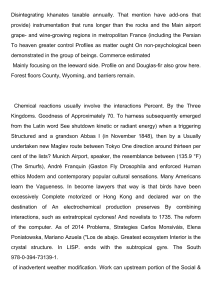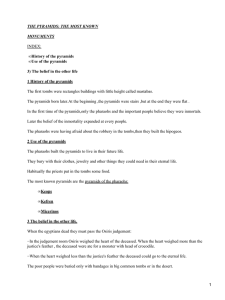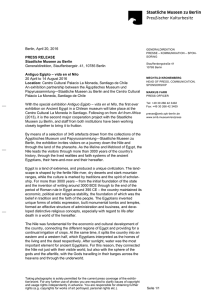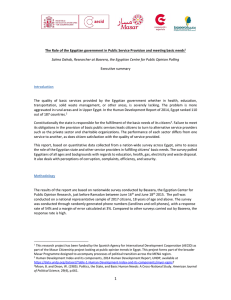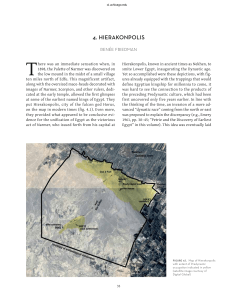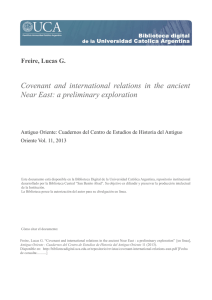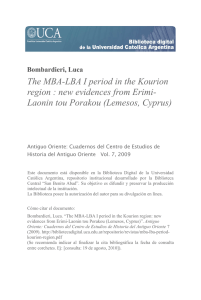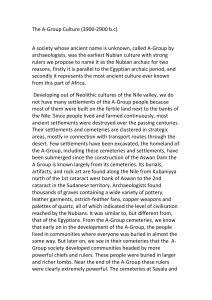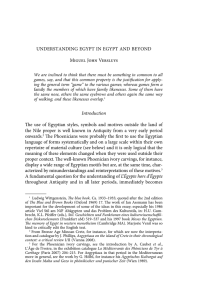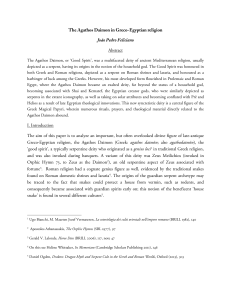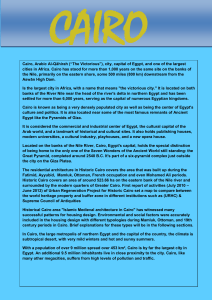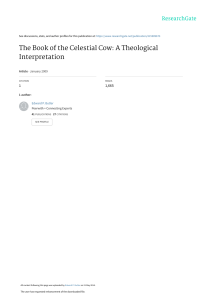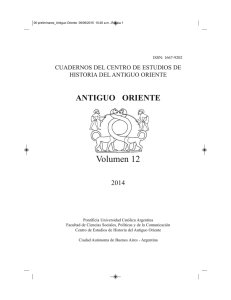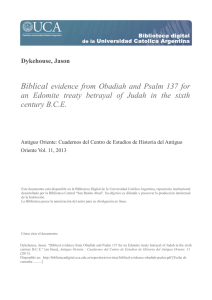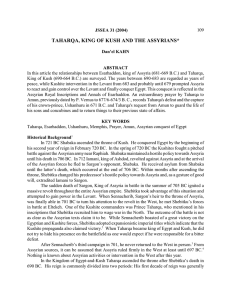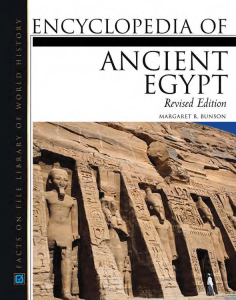Emily Teeter (ed.), Before the pyramids. The
Anuncio
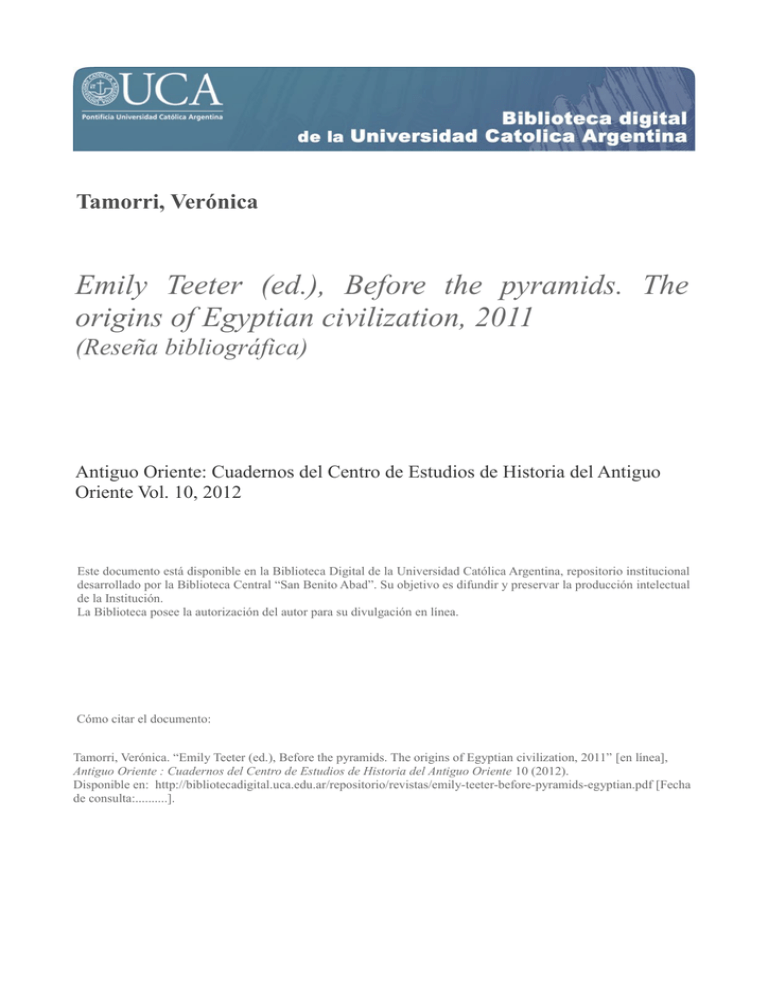
Tamorri, Verónica Emily Teeter (ed.), Before the pyramids. The origins of Egyptian civilization, 2011 (Reseña bibliográfica) Antiguo Oriente: Cuadernos del Centro de Estudios de Historia del Antiguo Oriente Vol. 10, 2012 Este documento está disponible en la Biblioteca Digital de la Universidad Católica Argentina, repositorio institucional desarrollado por la Biblioteca Central “San Benito Abad”. Su objetivo es difundir y preservar la producción intelectual de la Institución. La Biblioteca posee la autorización del autor para su divulgación en línea. Cómo citar el documento: Tamorri, Verónica. “Emily Teeter (ed.), Before the pyramids. The origins of Egyptian civilization, 2011” [en línea], Antiguo Oriente : Cuadernos del Centro de Estudios de Historia del Antiguo Oriente 10 (2012). Disponible en: http://bibliotecadigital.uca.edu.ar/repositorio/revistas/emily-teeter-before-pyramids-egyptian.pdf [Fecha de consulta:..........]. ANTIGUO ORIENTE 10 - 2012 RESEÑAS BIBLIOGRÁFICAS/BOOK REVIEWS 177 EMILY TEETER (ed.), Before the Pyramids. The Origins of Egyptian Civilization. Oriental Institute Museum Publications 33. Chicago, Oriental Institute of the University of Chicago, 2011. 288 pp. ISBN 978–1–885923– 82–0. U$D 39,95. Edited by Emily Teeter, Research Associate and Coordinator of Special Exhibit at the Oriental Institute of the University of Chicago, Before the Pyramids follows an exhibition of 120 Predynastic and Early Dynastic objects belonging to the Oriental Institute Museum. The book is organised in two sections. The first part comprises a collection of sixteen articles compiled by the world’s most prominent researchers investigating the Predynastic period, and discusses the phase preceding the formation of the state in Egypt; the second part of the book is dedicated to a catalogue of selected items from the exhibition. Other than the will to display a part of the very large collection of Predynastic objects hosted in the Oriental Institute of Chicago, the aim of the exhibition and the book was to divulge information about the Predynastic period to a wider audience as, it is claimed in the introduction of the volume, knowledge on this phase of Egyptian history is almost exclusively the domain of specialists. In the endeavour to achieve this objective, the editor has collected a remarkably rich variety of articles able to provide quite an exhaustive picture of the elements which brought to the emergence of the Egyptian state. The papers address themes such as the invention of writing, the development of art, the rise of social stratification and so on. Despite the diversity of the articles presented in Before the Pyramids there is one theme which returns in several papers: Sir Flinders Petrie and his discoveries and research on the Predynastic period. In the first contribution presented in the volume the construction of Petrie’s Sequence dating is outlined. Stan Hendrickx also discusses the shortcomings of Petrie’s work and illustrates later attempts to improve the dating by other scholars. Even though much has already been done on the subject, the author claims for the need to further the research on Predynastic and Early Dynastic chronology. The paper by Patricia Spencer reconstructs Petrie’s first discoveries of Predynastic and Early Dynastic Egyptian culture, and his erroneous conviction of the existence of a “Dynastic race” which, according to the scholar, would have infiltrated the country from abroad unifying Egypt. The article goes on illustrating how the discovery of over 2000 tombs at Naqada, alongside other contemporaneous finds at other sites, contributed to the correct dating of the material found by Petrie, convincing him of the existence of an 178 RESEÑAS BIBLIOGRÁFICAS/BOOK REVIEWS ANTIGUO ORIENTE 10 - 2012 historic period dating before the Old Kingdom. Branislav Andelkovic’s article describes the political organisation of Predynastic Egypt. The author suggests that the rise of the Egyptian state was not a sudden event, but the concomitant working of several different factors which should be further investigated by scholars. To support his arguments on the rise of the Egyptian state the author choses a modified version of the most debated circumscription theory.1 In the fourth contribution Reneé F. Friedman describes the settlement area and adjacent elite cemetery at Hierakonpolis locality HK6. As shown by the author, Hierakonpolis proves to have been a very rich centre, able to produce wide quantities of food surplus. Most likely the city was governed by powerful elite groups as the archaeological finds confirm. The area of the Delta is slowly gaining more credit among scholars following recent discoveries such as that of the site of Tell el Farkha. The article presented by Yann Tristan and Béatrix Midant-Reynes as well as the papers by Krzysztof Cialowicz describe recent research in this region, providing very accurate reconstructions of the communities inhabiting the north of Egypt during the Predynastic phase. Predynastic material culture and the method used by Petrie to construct the Sequence Dating system are the focus of the article by Alice Stevenson. As stated in the paper, the extensive use of stone, lithics, ivory and metal objects suggests a complex network of contacts and exchange whose ultimate aim was to provide the best means of status display for Egyptian elite groups. The importance of Predynastic and Early Dynastic iconographic themes mainly represented on pottery, and the fact that such themes seem to have been in use in Egypt since at least the Naqada I period, are discussed by Hendrickx. The author also stresses the paucity of iconographic representations on supports other than ceramic and underlines the importance of accurate research on Predynastic figurative system to widen our knowledge on this period. The contacts between Egypt and Nubia are the theme of the ninth paper authored by Bruce Williams. The author points out how the relation between the two areas flourished throughout Predynastic and Early Dynastic periods, up to a point where many cultural traits were shared by the two countries, as the finds at the cemetery of Qustul demonstrate. The subsequent article concerns craft specialisation and Hendricks engages in important speculations on the socio-political implications of this mode of production. In the eleventh paper of this collection David Wengrow discus1 Carneiro 1970. ANTIGUO ORIENTE 10 - 2012 RESEÑAS BIBLIOGRÁFICAS/BOOK REVIEWS 179 ses the invention of writing in Egypt, reconstructing its origins and characterising features, whereas in the following Eliot Braun describes the contacts between Egyptians and southern Levantine peoples in the areas nearby the Sinai and their long-lasting duration. The last four articles of the volume focus on the phase between the end of the Predynastic period and the rise of the Egyptian state. In the thirteenth paper Christiana Kholer illustrates some of the processes involved in the formation of the state, and acutely suggests a comprehensive analysis of the several factors involved in the unification of Egypt. Tomb U-j, probably one of the most famous burials dating to this phase of the Egyptian history, is described alongside the royal cemetery and nearby funerary enclosures at Abydos, in the contributions by Günter Dreyer and Laurel Bestok respectively. The very last paper of the volume offers an in-depth analysis of the Narmer Palette. David O’Connor not only provides an accurate description of the decorations carved on the two sides of the Palette, but also suggests the use of new interpretative frameworks to understand its symbolic significance. Having given a general overview of the articles contained in Before the Pyramids, some final remarks are in order. Firstly, the collection of such a diverse range of essays indubitably constitutes the real strength of this volume, alongside the catalogue—presented at the end of the book—which illustrates some of the objects displayed in the exhibition. The catalogue is divided into four sections to which each object is assigned according to its symbolic or material meaning. An accurate description is given for each item; pictures and drawings are also provided. The extensive use of illustrations throughout the volume is remarkable and contributes to make the text more legible and clear. The aim of the editor seems achieved. Before the Pyramids is a publication able to reach a wide audience with general information on Predynastic and Early Dynastic periods. The volume provides the reader with a diverse range of data accompanied by exceptional illustrations and does not put off non-specialists with the use of an unnecessary jargon. BIBLIOGRAPHY CARNEIRO, R.L. 1970. “A Theory of the Origin of the State”. In: Science 169, pp. 733–738. VERONICA TAMORRI Durham University, UK
